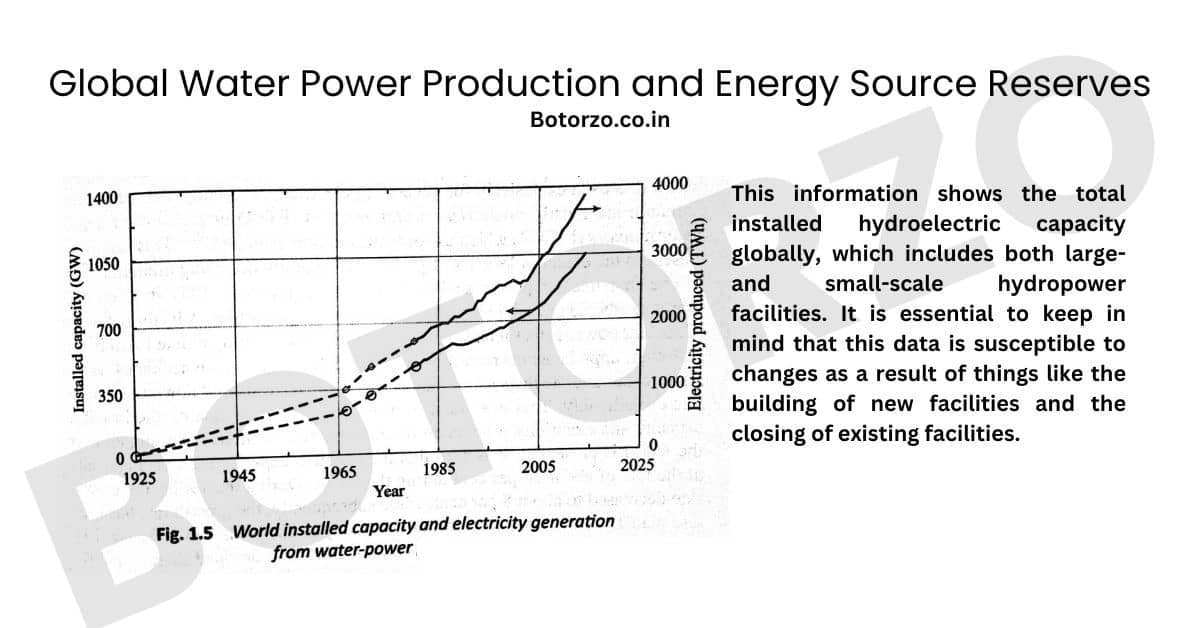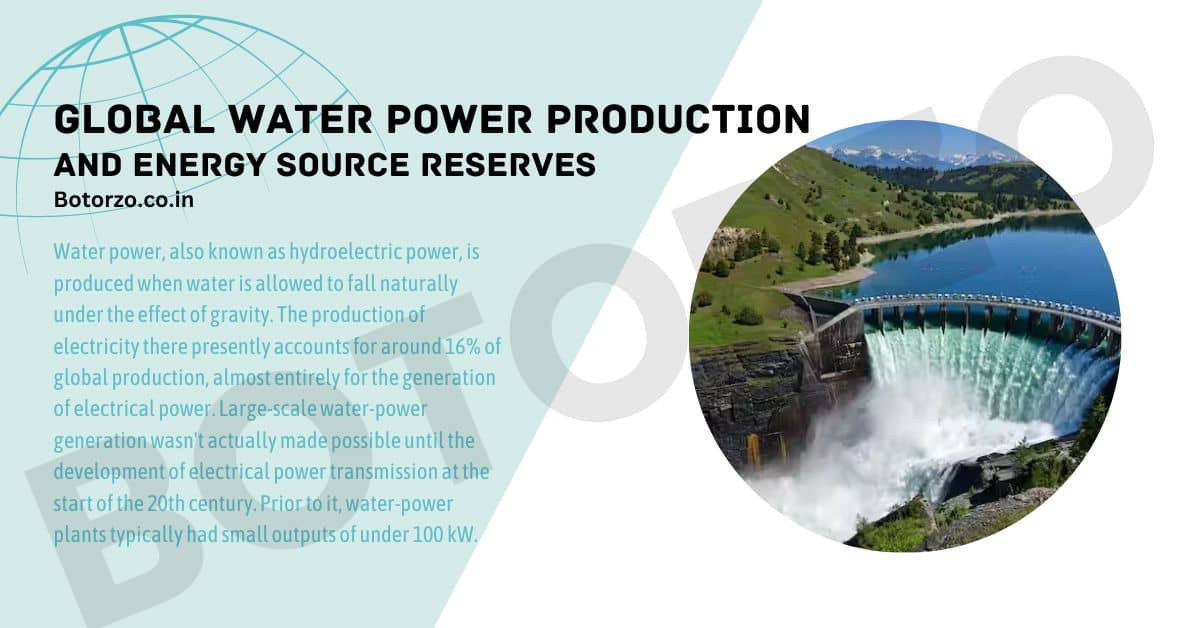Introduction
Water power, also known as hydroelectric power, is produced when water is allowed to fall naturally under the effect of gravity. The production of electricity there presently accounts for around 16% of global production, almost entirely for the generation of electrical power. Large-scale water-power generation wasn’t actually made possible until the development of electrical power transmission at the start of the 20th century. Prior to it, water-power plants typically had small outputs of under 100 kW.
Data related to water power
| 1925 [14] | 1966 [15] | 1971 [16] | 1980 [11] | |
| Installed capacity (MW) | 26 400 | 230 000 | 307 131 | 462 000 |
| Electricity produced (GWh) | 78 678 | 956 000 | 1 307 257 | 1 723 000 |
| Annual plant load factor | 0.340 | 0.474 | 0.486 | 0.426 |
The above table [1, 2–4] provides information on the installed water power capacity, electrical production, and yearly plant load factor for four sample years, 1925, 1966, 1971, and 1980. Fig. 1.5 also shows this data as well as annual data starting in 1980. It can be shown that between 1925 and 1980, the yearly growth in capacity was between 4% and 5%. After that, between 1980 and 2014, the yearly rise typically fell between 2 and 3%.

The installed capacity of hydropower has been gradually increasing, according to the International Energy Agency (IEA), throughout the past few decades. About 667 GW (gigawatts) of hydropower capacity was constructed in 1999. The installed capacity was roughly 1,330 GW by 2020.
This information shows the total installed hydroelectric capacity globally, which includes both large- and small-scale hydropower facilities. It is essential to keep in mind that this data is susceptible to changes as a result of things like the building of new facilities and the closing of existing facilities.
Read About Global Coal Production
annual plant load factor
The annual plant load factor (APLF) is a metric that measures the efficiency of a power plant. Specifically, it is the ratio of the actual electricity produced by a power plant over a given period to the theoretical maximum electricity that could have been produced if the plant had operated at full capacity throughout that same period.
For water-power plants, the APLF is often affected by factors such as shutdowns for maintenance and repairs, and the non-availability of the optimum level of water required in the dams for generating the installed capacity throughout the year. These factors can cause the actual electricity production to fall short of the theoretical maximum, resulting in a lower APLF value.
average APLF for water-power
From 2004 to 2014, the world’s average APLF for waterpower was 0.42. This means that, on average, water-power plants worldwide were operating at only 42% of their theoretical maximum capacity. The low APLF value can be attributed to the factors mentioned above, as well as other factors such as changes in water levels due to seasonal variations, environmental regulations, and unexpected events such as extreme weather conditions or natural disasters.
Improving the APLF of water-power plants is an ongoing challenge for the industry, as it requires careful planning and management of plant operations, maintenance, and environmental factors. Efforts to increase APLF can include measures such as improving the efficiency of plant equipment, optimizing water management practices, investing in new technologies, and increasing collaboration between industry stakeholders to share best practices and knowledge.
Estimates of the total capacity of water-power that can be installed worldwide vary depending on the assumptions made in the calculations. One approach is to estimate the maximum generation that can be used 95% of the year. Using this method, it has been estimated that the total capacity that can be installed is approximately 3 million megawatts (MW) [5].
World Energy Council data for water power
However, recent estimates by the World Energy Council suggest that the technically exploitable potential of water-power is much higher, at around 10,000 terawatt hours (TWh) per year [6]. This estimate takes into account the potential of all types of water-power, including large-scale hydropower projects as well as small-scale installations.
Furthermore, much of the potential capacity that has yet to be installed is located in developing countries. This presents a significant opportunity for these countries to increase their production of hydroelectric power, which can be a cost-effective and reliable source of electricity.
Expanding the production of hydroelectric power can have a range of benefits, including reducing dependence on fossil fuels, lowering greenhouse gas emissions, and promoting energy security. However, it is important to note that there can be environmental and social impacts associated with large-scale hydropower projects, such as displacement of local communities and impacts on biodiversity and aquatic ecosystems. These impacts should be carefully assessed and managed to ensure that the benefits of hydroelectric power can be realized while minimizing negative effects.
Conclusion
Hydroelectricity is the main renewable energy source employed in today’s commercial sector that has no effect on global warming. However, whenever large dams are constructed in order to generate hydroelectric power, a number of social and environmental concerns are brought up. One of the issues with the environment is that the ecosystem would suffer if any biological species became extinct. Another concern is the potential for the enormous volume of water stored behind the dam to intensify local seismic activity. The displacement of residents from flooded areas during the construction of a new dam is a significant societal problem.
Frequently Asked Questions
What is the annual plant load factor (APLF) for water power for the world as a whole from 2004 to 2014?
The APLF for water power had an average value of 0.42 from 2004 to 2014.
What is the estimated total capacity of water power that can be installed in the world?
The estimated total capacity of water power that can be installed in the world varies, but according to one method that states the maximum generation usable 95% of the year, it is estimated to be 3 x 106 MW. Recent estimates by the World Energy Council show that the technically exploitable potential of water power is 10,000 TWh/year.
What are some environmental concerns raised when large dams are constructed for hydroelectric power?
One environmental concern is the potential destruction of certain biological species, which can be harmful to the ecosystem. Another concern is that the large body of water stored behind the dam may trigger more seismic activity in the region.
What are some social concerns raised when large dams are constructed for hydroelectric power?
Social concerns are largely concerned with the displacement of people who live in areas that get submerged when a new dam is being built.
Potential Questions Related To this Article
- What is water power and how is it used?
- When did large-scale water power generation become possible?
- What is the installed capacity of water power, and how has it changed over time?
- How much of the world’s electricity production comes from water power?
- Is there any information on the annual increase in water power capacity over time?
References
1.) International Energy Statistics. Energy Information Administration, Department of Energy, Washington, U.S.A
2.) Darmstadter, J. 1970. Energy in the World Economy. Johns Hopkins, Baltimore, U.S.A.
3.) Encyclopedia of Energy. 1973. McGraw Hill, New York, U.S.A.
4.) World Energy Supplies. 1973. United Nations J. Series, New York, U.S.A.
5.) Survey of Energy Resources. 1974. US National Committee of the World Energy Conference, 345E, 47th Street. New York, U.S.A.
6.) World Energy Resources – Charting the Upsurge in Hydropower Development. 2015. World Energy Council, London, U.K
Our Another Domains Vidyapedia.in And Uietmdu.in

